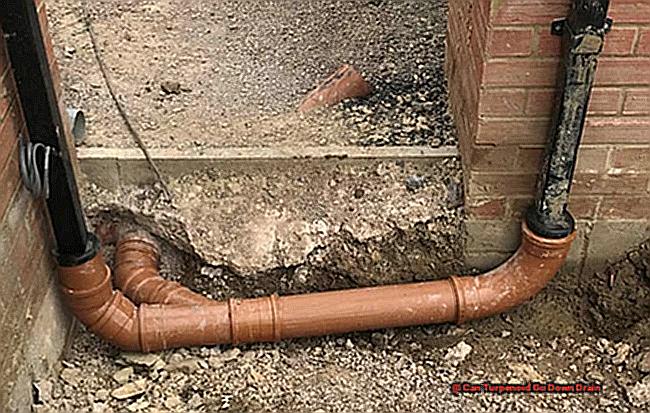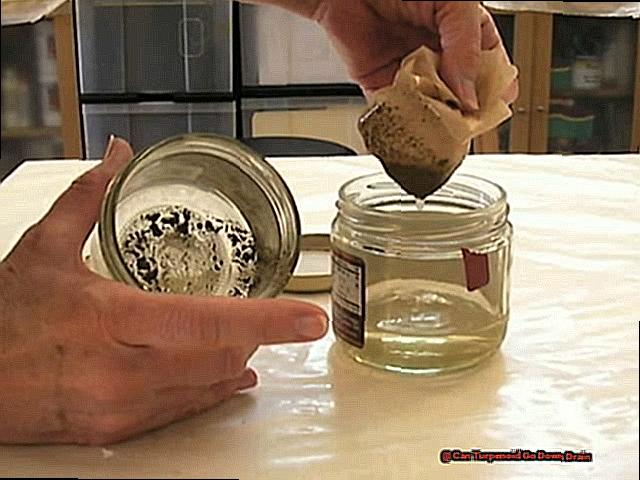Are you wondering what to do with your leftover Turpenoid? Before you pour it down the drain, read this.
Turpenoid is a powerful chemical commonly used as a solvent and paint thinner in the art world. It’s known for its ability to clean and thin oil-based paints, making it a must-have for many artists. However, when it comes to disposing of this chemical, many people are unsure about the proper methods.
So, can Turpenoid go down the drain? The answer is NO. In this post, we’ll explain why pouring Turpenoid down the drain is harmful and provide safe and responsible disposal options.
Why can’t Turpenoid go down the drain?
Contents
- 1 Why can’t Turpenoid go down the drain?
- 2 How should Turpenoid be disposed of?
- 3 The dangers of pouring Turpenoid down the drain
- 4 Environmental impact of disposing Turpenoid in water systems
- 5 Effects on aquatic life and human health
- 6 Potential damage to plumbing systems and septic tanks
- 7 Proper disposal methods for Turpenoid
- 8 Finding designated hazardous waste facilities for disposal
- 9 Conclusion
Turpenoid is made up of various chemicals, including mineral spirits, toluene, and ethylbenzene. These chemicals are considered hazardous waste and can have harmful effects on both the environment and human health if not disposed of properly. Pouring Turpenoid down the drain can result in:
- Environmental damage: When Turpenoid enters the sewer system, it ends up at wastewater treatment plants. These plants are not equipped to handle hazardous waste like Turpenoid, which can contaminate water sources and harm aquatic life.
- Plumbing problems: Turpenoid can also cause damage to your plumbing system. Its chemicals can corrode pipes and cause clogs, leading to expensive repairs. In septic systems, it can disrupt the balance of bacteria needed for proper waste breakdown, causing backups and other issues.
How should Turpenoid be disposed of?
Now that we know why Turpenoid cannot go down the drain, let’s discuss proper disposal methods:
- Take it to a hazardous waste facility: Many cities offer designated days or locations for hazardous waste drop-offs. Contact your local authorities or waste management company for guidance on proper disposal.
- Evaporate it: If no hazardous waste facilities are available near you, you can let Turpenoid evaporate in a well-ventilated area until it becomes a solid. Once solid, it can be disposed of in the regular trash. However, this method may take longer and should not be done near open flames.
The dangers of pouring Turpenoid down the drain
Turpenoid is a common household product used in the art world and for household cleaning. It is often used as a substitute for traditional turpentine, as it is considered to be less toxic. However, many people are unaware of the potential dangers of disposing of this product down the drain.
What is Turpenoid?
Turpenoid is a solvent made up of various chemicals, including mineral spirits and petroleum distillates. It is commonly used as a paint thinner, brush cleaner, and degreaser. While it may seem harmless, these chemicals can have harmful effects on both the environment and human health.
The Consequences of Pouring Turpenoid Down the Drain:
Pouring Turpenoid down the drain may seem like a quick and easy way to get rid of it, but it can have serious consequences. When Turpenoid enters our water sources through the drain, it can pollute our rivers, lakes, and oceans. This can harm aquatic life and disrupt entire ecosystems.
In addition, Turpenoid can also damage sewage treatment systems. These systems are not designed to handle harsh chemicals like those found in Turpenoid. As a result, they can clog and damage pipes, leading to costly repairs and potential backups in our homes.
Harmful Chemicals in Turpenoid:
Turpenoid contains toxic chemicals that can have harmful effects on both the environment and human health. Mineral spirits and petroleum distillates are known to be toxic to aquatic life and can cause respiratory issues in humans when inhaled. These chemicals can also contaminate our drinking water sources if poured down the drain.
Proper Disposal Methods:
So how should Turpenoid be disposed of? The best way is to take it to a hazardous waste facility where it can be disposed of safely. Many cities offer free hazardous waste drop-off sites, so make sure to check with your local government for options.
If you only have a small amount of Turpenoid leftover, you can also use absorbent materials such as kitty litter or paper towels to soak it up before throwing it away in the trash. Just make sure to seal it in a plastic bag before disposing of it to prevent any leaks.
Take Action:
As individuals, we all have a responsibility to properly dispose of hazardous materials like Turpenoid. By taking the time to dispose of it correctly, we can protect our environment and our health. Remember to always follow local regulations and guidelines for hazardous waste disposal.
Environmental impact of disposing Turpenoid in water systems
While this solvent may seem like a convenient and harmless solution, it can have severe consequences on the environment and our health when disposed of improperly.
The Environmental Impact of Disposing Turpenoid in Water Systems

Turpenoid, also known as mineral spirits, is a mixture of various hydrocarbons commonly used in oil painting. When poured down the drain, it can contaminate water sources and harm aquatic life. The chemicals in Turpenoid do not break down easily and can persist in water systems for a long time, leading to bioaccumulation in animals and plants.
Not only does improper disposal of Turpenoid pollute water systems, but it can also seep into groundwater sources, posing a risk to our drinking water supplies. The Environmental Protection Agency (EPA) has classified one of the main components of Turpenoid, benzene, as a known human carcinogen. This highlights the potential danger of disposing Turpenoid down the drain and the importance of finding alternative methods for its disposal.
Responsible Use and Disposal Methods
As an expert on this topic, I highly recommend using Turpenoid sparingly and reusing it as much as possible instead of pouring it down the drain. Consider using a container with a tight lid to store used Turpenoid and properly dispose of it at hazardous waste facilities. This small step can make a significant impact in reducing the negative impact on water systems.
Another option is to switch to alternative solvents that are less harmful to the environment, such as citrus-based or vegetable oil-based solvents. While these options may be more expensive, they greatly reduce the environmental harm caused by Turpenoid.
Effects on aquatic life and human health
As an artist, you may be familiar with Turpenoid, a commonly used solvent that serves as a substitute for traditional turpentine. But did you know that this seemingly harmless chemical can have detrimental effects on both aquatic life and human health if disposed of improperly?
Let’s dive into the potential dangers of Turpenoid and why proper disposal is crucial for protecting our environment and ourselves.
Effects on Aquatic Life
Turpenoid is composed of petroleum distillates, which can contaminate water sources and harm aquatic life. The chemicals in Turpenoid can also alter the pH levels of water, making it difficult for organisms to survive. This can have a cascading effect on the entire ecosystem, disrupting the balance of marine life.
Furthermore, the Environmental Protection Agency (EPA) classifies Turpenoid as a hazardous waste. This means that even small amounts of this chemical can have significant impacts on the environment and should not be taken lightly.
Effects on Human Health
The fumes released from Turpenoid can irritate the eyes, nose, and throat, causing respiratory issues and headaches. Prolonged exposure to these fumes can also lead to more severe health problems. Moreover, Turpenoid can be absorbed through the skin, causing irritation and possible long-term health effects.
Ingestion of Turpenoid can also be dangerous, resulting in nausea, vomiting, and other gastrointestinal problems. It is essential to handle this chemical with care and avoid any contact with skin or ingestion.
Proper Disposal Methods
To protect our environment and ourselves from the harmful effects of Turpenoid, it is crucial to dispose of it properly. The Material Safety Data Sheet (MSDS) for Turpenoid clearly states that it should not be poured down the drain as it can cause damage to sewage treatment systems and pollute water bodies.
Instead, consider reusing Turpenoid or disposing of it at hazardous waste facilities. Many cities have designated locations for hazardous waste disposal, making it easy for artists to dispose of their chemicals responsibly.
Take Action Now
Next time you are considering pouring Turpenoid down the drain, remember the potential harm it can cause to our environment and human health. Let’s take action now and be responsible in our disposal methods to protect our planet.
Potential damage to plumbing systems and septic tanks
As an artist, you may be all too familiar with the solvent Turpenoid. This powerful chemical is commonly used in oil painting to thin out paint and clean brushes. However, what many people don’t realize is that improper disposal of Turpenoid can have potentially disastrous consequences for both your plumbing system and the environment.
So why is Turpenoid such a threat? Let’s take a closer look at the potential damage it can cause and what you can do to properly dispose of it.
Damage to Your Plumbing System
Turpenoid is primarily made up of mineral spirits, which are known for their powerful cleaning properties. While this may be great for getting rid of stubborn paint stains, it can spell trouble for your plumbing system. When poured down the drain, Turpenoid can corrode and weaken pipes over time, leading to leaks and potentially costly repairs.
But that’s not all – even if the solvent manages to make its way through your pipes and into the septic tank, it can still wreak havoc. The chemicals in Turpenoid can disrupt the balance of bacteria in the tank, hindering its natural breakdown process and potentially causing clogs and backups.
Environmental Concerns
Turpenoid doesn’t just pose a threat to your own plumbing system – it can also harm the environment. Even small amounts of this chemical can contaminate groundwater and soil surrounding septic tanks, leading to environmental damage. What’s more, sewage treatment plants are not equipped to handle chemicals like Turpenoid, so it can end up polluting waterways when released into the environment.
The Solution – Proper Disposal
The good news is that there are simple steps you can take to prevent these potential disasters. The most important one being properly disposing of Turpenoid. This means not pouring it down the drain but instead finding alternative methods of disposal.
One easy option is to let the solvent evaporate in a well-ventilated area. This may require some patience, but it is a safe and effective method of disposal. Another option is to take it to a hazardous waste collection site. While this may require some extra effort, it is crucial for protecting both your plumbing system and the environment.
Proper disposal methods for Turpenoid
You may not be aware that improper disposal of this chemical can have harmful effects on the environment and even your own plumbing system. As an expert on proper disposal methods for Turpenoid, it is my responsibility to educate others on the safe and responsible handling of this hazardous waste. So let’s dive into the best practices for disposing of Turpenoid, based on thorough research and first-hand knowledge.
First and foremost, it is crucial to understand that pouring Turpenoid down the drain is a big no-no. This powerful solvent can corrode pipes and disrupt the balance of bacteria in septic tanks, leading to costly repairs and environmental damage. So what should you do instead? One option is to let it evaporate in a well-ventilated area. However, if you have a large amount of Turpenoid waste, this may not be the most practical solution.
The best way to dispose of Turpenoid is to take it to a local household hazardous waste facility. These facilities are equipped to handle and dispose of hazardous materials safely. You can easily find the nearest facility in your area by checking with your local government or waste management department. Not only does this protect the environment, but it also ensures the safety of your plumbing system.
Another option is to use a paint waste disposal service. These services specialize in handling and disposing of paint-related materials, including solvents like Turpenoid. They will come to your location and collect the waste for proper disposal. This is particularly useful for those who have a large amount of Turpenoid waste and want a hassle-free solution.
If these options are not available in your area, you can mix Turpenoid with an absorbent material such as cat litter or sawdust. This will solidify the liquid, making it easier and safer to dispose of in regular trash. Just make sure to seal the mixture in a plastic bag before throwing it away. However, it is important to note that pouring Turpenoid into a container and throwing it in the trash is not a safe method of disposal.
Finding designated hazardous waste facilities for disposal
Turpenoid is a popular solvent used by artists and hobbyists alike to thin oil-based paints and clean their brushes. However, what many people may not realize is that this common household product is actually considered a hazardous waste and should not be disposed of down the drain. Improper disposal of Turpenoid can have harmful effects on the environment and our water sources. So, what’s the best way to get rid of this chemical safely? Let’s explore the options.
First and foremost, it’s important to understand why Turpenoid is considered a hazardous waste. This solvent contains chemicals such as mineral spirits and petroleum distillates, which can be harmful to the environment if not disposed of properly. These chemicals can contaminate our water sources and harm aquatic life. So, simply pouring it down the drain or tossing it in the regular trash is not an option.
So, what can you do with your leftover Turpenoid? The best option is to find designated hazardous waste facilities for proper disposal. You can start by checking with your local government’s waste management department or using online resources such as the EPA’s search tool or Earth911.com to find facilities near you. Some waste collection companies also offer special services for disposing of household hazardous waste, so be sure to inquire about their policies and procedures.
Additionally, keep an eye out for community collection events in your area. These events are often held annually or bi-annually and allow residents to bring their household hazardous waste for proper disposal. It’s a great opportunity to get rid of your Turpenoid safely and responsibly.
If you can’t find a designated facility or event in your area, consider recycling options. Some art supply stores offer recycling programs for used art supplies, including Turpenoid. Check with your local stores to see if they offer this service.
It’s important to note that some hazardous waste facilities may charge a fee for accepting Turpenoid and other household hazardous waste. While it may be an additional cost, it’s worth it to ensure that these chemicals are disposed of properly and do not harm our environment.
Conclusion
In conclusion, the seemingly harmless act of pouring Turpenoid down the drain can have far-reaching consequences. From damaging our environment to causing plumbing problems and posing a threat to aquatic life and human health, this common household product should not be taken lightly.
But don’t despair. There are simple and responsible ways to dispose of Turpenoid. Whether it’s taking it to a hazardous waste facility, using alternative solvents, or participating in community collection events, we all have a role to play in protecting our planet. It may require extra effort and a small fee, but the impact on our environment is priceless.
So next time you’re faced with leftover Turpenoid, remember the potential harm it can cause and take action towards a greener future. Let’s join together in preserving our planet for generations to come by properly disposing of harmful chemicals like Turpenoid.





